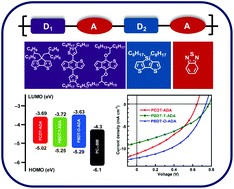Dithienosilole-benzothiadiazole-based ternary copolymers with a D1–A–D2–A structure for polymer solar cells
Abstract
A series of narrow band gap conjugated copolymers comprising two electron-rich (donor, D) and one electron-deficient (acceptor, A) moieties regularly alternating along the polymer backbone were designed and synthesized. The ternary copolymers with the repeating unit in a D1–A–D2–A manner were constructed by copolymerizing a bisstannyled-D1 (D1 = cyclopentadithiophene or benzodithiophene-derivatives) and a dibromo-monomer (Br–A–D2–A–Br, D2 = dithienosilole, A = benzothiadiazole) through a palladium-catalyzed Stille polymerization. It was recognized that the optical properties, frontier molecular orbital energy levels and the photovoltaic performance of the resulting copolymers can be influenced by modifying the copolymerized D1 moiety. By carefully optimizing the electron-donating behaviours and substitutions of the D1 unit, bulk-heterojunction solar cells with a power conversion efficiency of 4.11% were achieved based on an inverted device configuration of ITO/PFN-OX/PBDT-O-ADA:PC71BM/MoO3/Al. These results demonstrated that the construction of regularly alternating narrow band gap conjugated ternary copolymers can be an effective strategy for the development of electron-donating materials for polymer solar cells.


 Please wait while we load your content...
Please wait while we load your content...